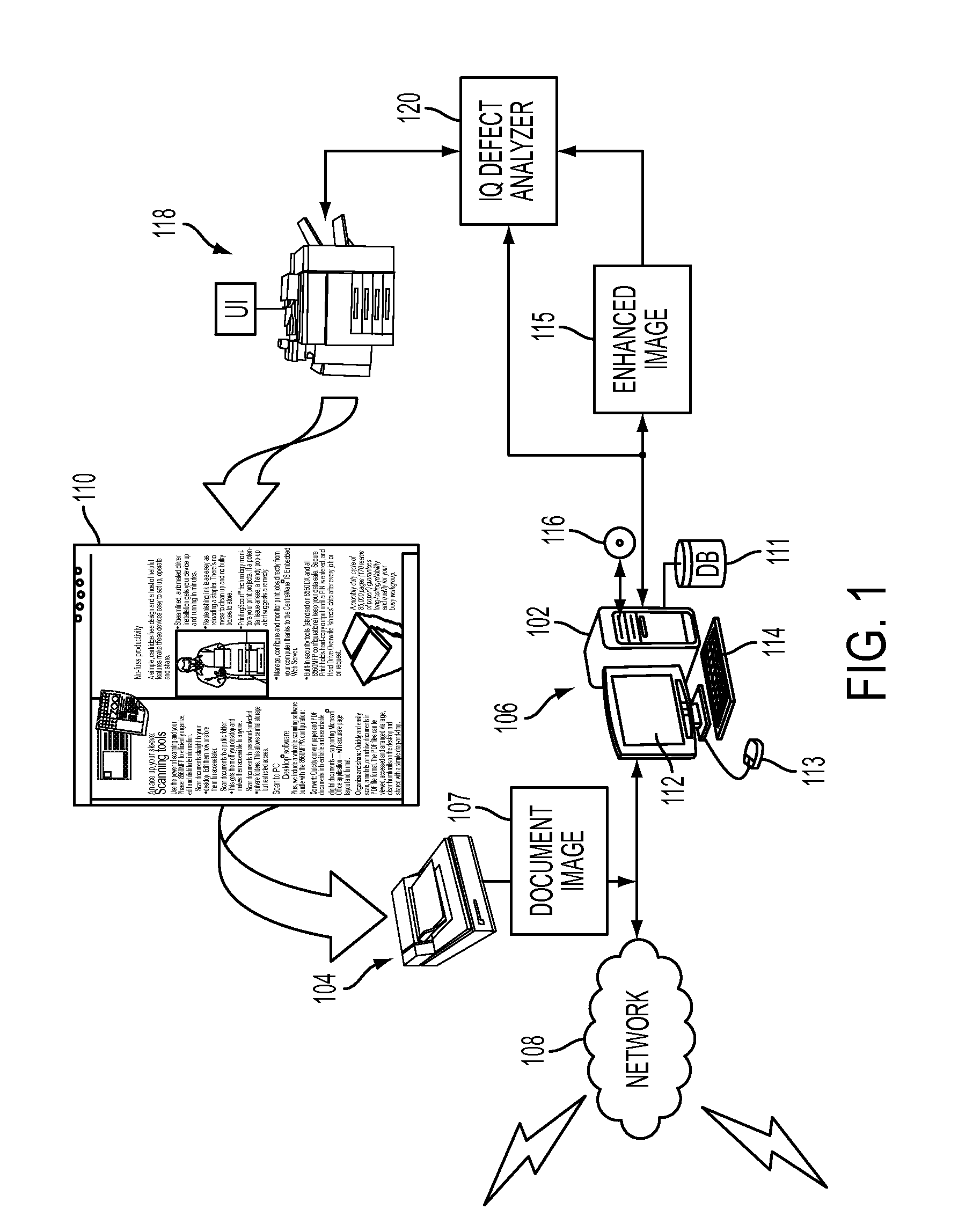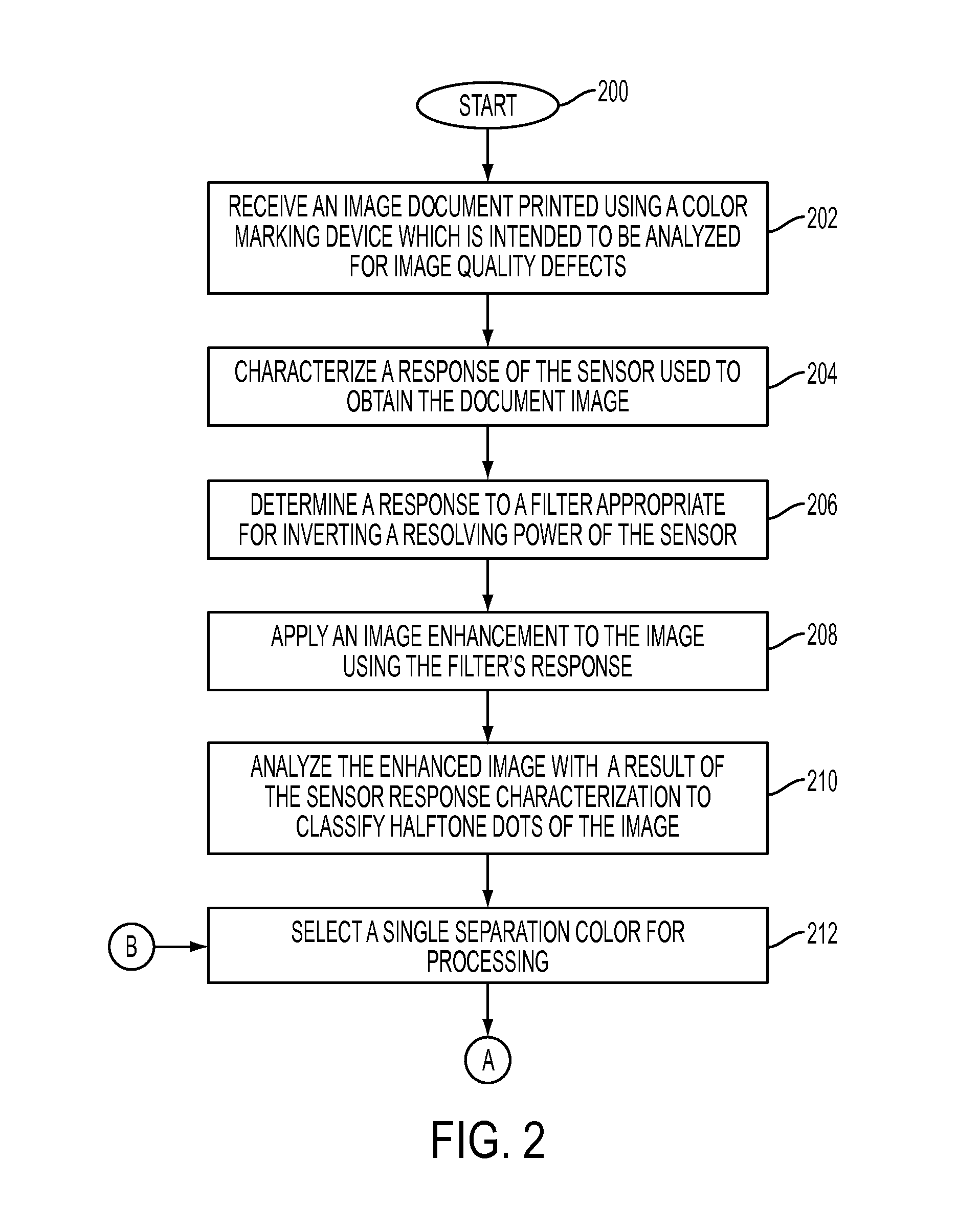Image quality defect detection via sensor characterization and halftone dot classification
a technology of image quality and sensor characterization, applied in the field of image quality defect detection via sensor characterization and halftone dot classification, can solve the problems of waste of paper, objectionable streaks for customers, undesirable to insert test patterns into customers' jobs,
- Summary
- Abstract
- Description
- Claims
- Application Information
AI Technical Summary
Benefits of technology
Problems solved by technology
Method used
Image
Examples
first embodiment
Flow Diagram of a First Embodiment
[0045]As discussed in the background section hereof, there are two primary approaches to image quality defect detection such as WMJ detection, streak detection, banding detection, mottle detection, graininess detection etc. For image quality defect detection, there are methods that do not identify individual halftone dot directly but estimate the average amount of halftone dots (referred to as analysis in macro-view), i.e., approaches that analyze average colors across many pixels for defects. On the other hand, there are methods that attempt to identify individual halftone dots directly (referred to as analysis in micro-view), i.e., approaches that attempt to identify at the pixel level the color of the halftone dot and then determine the presence of image defects. There are advantages and disadvantages in both approaches. Using WMJ detection as an example, for the macro-view approach, the process direction resolution can be very low (e.g., 5 dpi)....
second embodiment
Flow Diagram of a Second Embodiment
[0063]In this embodiment, instead of manipulating pixel values of the scans via filtering as in the above-described embodiment and then applying a two-stage halftone classification approach where these values are first compared to a spatially-invariant RGB→CMYK LUT and then optionally a subset of pixels are compared to a spatially varying RGB→CMYK LUT, a spatially varying RGB→CMYK LUT is created which is tailored for each pixel based on the pixel values of surrounding pixels. Then, each pixel at location (i,j) is classified to one of the 16 halftone dots based on a closest Euclidean distance to the modified centroids of the 16 primaries of the characterized sensor response. Here, the modification is based on the weighted average of values of pixels in a neighborhood of pixels surrounding center pixel (i,j) (pixel (i,j) is excluded) and the original spatially-invariant centroids of the 16 primaries (Table of FIG. 7).
[0064]Reference is now being made...
example functional
[0072]Reference is now being made to FIG. 10 which illustrates a functional block diagram of one embodiment of an example image quality processing system wherein various aspects of the present method for image quality defect analysis via halftone dot classification can be performed. The system illustrates a plurality of image input devices, at 1000, each capable of capturing the document image (110 of FIG. 1) and providing an image document 1016 to image quality processing module 1018 shown residing as any of a hardware or software embodiment within computer system 102.
[0073]In FIG. 10, an image of a customer document is captured using any of a variety of input devices such as, for instance, a digital camera 1002 or using a copying function of print system 1004. A document image may be captured using document scanning device 1006. The customer's document may reside on a color film 1008 and captured via transparency input device 1014. The document image may be retrieved ...
PUM
 Login to View More
Login to View More Abstract
Description
Claims
Application Information
 Login to View More
Login to View More - R&D
- Intellectual Property
- Life Sciences
- Materials
- Tech Scout
- Unparalleled Data Quality
- Higher Quality Content
- 60% Fewer Hallucinations
Browse by: Latest US Patents, China's latest patents, Technical Efficacy Thesaurus, Application Domain, Technology Topic, Popular Technical Reports.
© 2025 PatSnap. All rights reserved.Legal|Privacy policy|Modern Slavery Act Transparency Statement|Sitemap|About US| Contact US: help@patsnap.com



